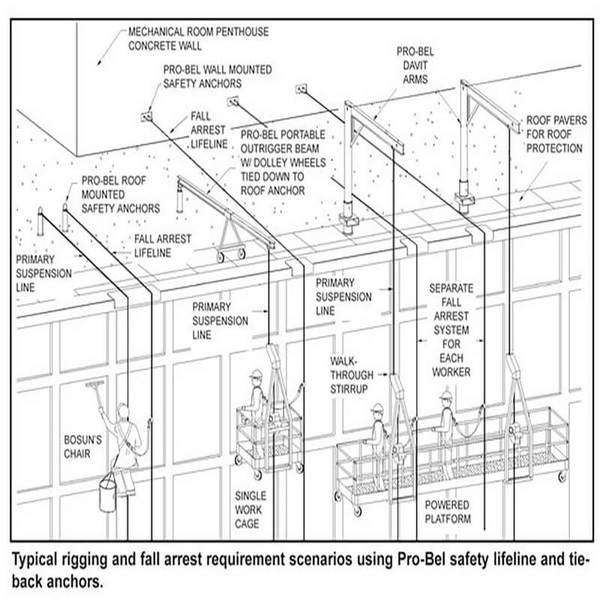Fall arrest and tie-back anchors are primarily designed to protect workers from falls while working on or over the roof edge.
While a clear understanding of codes, regulations, and standards is of the utmost importance; the first consideration (after safety of course) is function when designing proper window washing, suspended maintenance, and fall protection systems. Often buildings will install a system only to meet the needs to comply with building codes, Federal standards, and safety regulations. It is however essential to consider function to achieve and ensure long term success of any system.
What is Function?
Firstly, you must consider what type of work is being completed while the system is in use?
- Window washing
- Exterior building maintenance (caulking, restoration, replacement, etc.)
- Fixing/servicing/replacing equipment (cooling tower, drains, mechanical units) on the roof
(If you would like to read more about this then please see https://pro-bel.ca/blog/category/basics-of-fall-protection/)
Secondly, you must consider if the workers will think the system is convenient and easy to use. This beyond anything else is the first thing that will jeopardize a workers safety. Like all professions really, a worker will bypass or modify elements of the system if they believe it is inefficient and slowing down their pace.
Technical Audits
It is fortunate to note that building technical audits (for warranty programs) are becoming more concerned with inadequately designed and impractical systems. The audits are bringing this to the building’s attention as a way of saying that the inconvenient system is just as dangerous as a poorly engineered system because no worker will use it.
The Design Process
If you want to ensure that a system is compliant and efficient; manufacturers like Pro-Bel will work closely with architects, construction manager, engineers, and general contractors to provide design services which encourage and initiate discussions regarding the design (at an early stage of the design process).
This process seeks to:
- Collect and analyze safe access and egress methods
- Determine unique building needs
- Establish functional and common relationship in equipment locations
- Establish maintenance goals
- State conventional rigging problems and methods
- Uncover test methods and inspection practices
Budget
This process also looks to balance budget, compliance, and function. It must be stressed that caution should be used when budget is the main consideration for any design (as functionality is the first factor to go).
The design process discussions have a significant impact on the design of the system (and building even) as there are various perspectives included in the conversation. It is almost a way of conducting thorough due diligence and quality assurance.
Please like us on Facebook (www.facebook.com/ProBelPB) and follow us on Twitter (www.twitter.com/ProBelPB).






